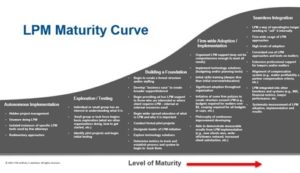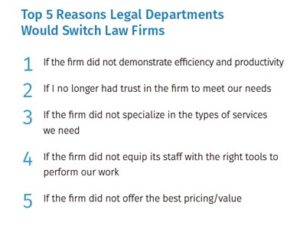On February 10th, I was honored to co-chair the annual Practising Law Institute program on Project Management for Lawyers. There were over 600 people registered. For the first time, the in-house lawyers from corporate or government law departments outpaced the private practice attendees by 50%.
In preparing for that, I considered the changes we’ve seen across the legal market in the 12 years that I have co-chaired the event and how LPM has evolved and changed. Some of the key trends affecting LPM today are outlined below.
LPM is Here to Stay
In most organizations, LPM is a relatively recent development in legal practice, having emerged 15 or so years ago. But it’s not new. Project management has been around since the pyramids were built in Egypt. In the US, it’s been popular since the early days of industrial manufacturing. The Project Management Institute, one of the largest professional associations in the world, was founded over 50 years ago and project management has been a practice in most industries for many decades.
In law firms, much of the growth in the use of legal project management has occurred in the last five years, although a handful of pioneering firms have been using it for more than 10. Some leaders in law departments have described it as table stakes in the PLI program in the past 5 years. But there are still some legal organizations where the idea of using project management approaches to enhance the delivery of legal services is still virtually unheard of.
Among the audience surveyed during the program:
- 69% indicated that they use some type of kick off meeting at matter outset with all or most members of the matter team
- 48% indicated that they use some version of project charters, scope or statement of work documents (and another 9% planning to do so)
- 64% indicated that they use some version of project plans (and 5% more planning to do so)
- 47% using budget templates (and 5% more planning to do so)
On the other hand, when those in legal departments were asked “how regularly does your law firm update you on the financial status of a matter,” 42% said “rarely.” I am sure the project management professionals attending were appalled. It is one of the critical areas that the legal operations are trying to change.

Shown above is the maturity curve we launched about five years ago with the Advisory Board of the LPM Institute and at the PLI program the same year. As you can see, there has been a dramatic increase in the number of law firms across the US and around the globe that are now in the upper levels of maturity. This means there are high levels of LPM adoption across their lawyer populations.
Last June, I chaired the Global LPM Summit. This is the first global conference on this topic with over 75 speakers from a dozen countries. It was gratifying to hear from many of the speakers from the UK, who revealed that they no longer have to push for lawyer buy-in. LPM is widely accepted in their organizations. Two things are becoming increasingly clear: (1) the use of LPM is widely accepted in many organizations around the globe: and (2) many law departments expect LPM approaches to be used on their matters. LPM really is here to stay.
Challenges for Integration Continue
Despite high levels of buy-in at firms with large LPM teams and robust adoption of LPM approaches in many law firms, there remains a challenge. In some firms, legal project managers still struggle to get the level of authority that project managers have outside legal.
In the world beyond legal, in business around the world, project managers are driving and directing projects. The tall buildings in downtown centers, the airplanes that carry us across the country, the schools our children attend — none of these things would exist without a project manager directing the details of that construction. In technology, health care, manufacturing and more, project managers direct and lead others to accomplish the projects. In legal, the role in many firms is still one mainly in the background – guiding the planning, monitoring, and influencing – but without the ability to “tell” lawyers what to do, much less tell partners what to do.
However, increasingly, in law firms with high adoption of LPM, legal project managers are seen as highly valued professionals. They help the matter teams run effectively and meet client expectations. In many firms, they are client facing, helping the leaders of matter teams ensure they are meeting and exceeding client expectations. Further, they help navigate issues ranging from changing the staffing on a matter, setting up a client-facing dashboard, discussing scope changes and the impact on the budget and more.
Legal Project Managers are in Great Demand
Despite the gap in position power that I just mentioned, the demand for these roles is growing exponentially. That’s because legal organizations realize the positive impact legal project managers can have on the bottom line – reducing legal spend for a law department or improving profitability and client relationships on the law firm side. There are law firms with teams of 50+ legal project managers servicing the thousands of matters their firms handle each year. They are assisted by a mix of consultative help and training, and templates provided to the lawyers for self-help.
With so many law firms hiring legal project managers — whether their first or their 50th— there is a real shortage of talent in the last few years. Some legal project managers have moved from one firm to another, often for a better title, greater compensation, or both. This has resulted in some firms training their own talent from within, for example, paralegals, associates, or other roles. (https://lawvision.com/how-to-build-and-scale-your-lpm-team/#.Yh0kuS-B2fU)
Some firms in the UK have taken the approach of building a talent pipeline by training college graduates in various legal operations areas including LPM. In other cases, firms have hired independent legal project managers, who are essentially LPM consultants who can be seconded to the firm to fill a gap in capacity. This may include, for example, taking the place of a person out on leave or while they are in the process of hiring a project manager full-time. My colleague and partner, Carla Landry, has been seconded to two firms over the past year or so in this type of role.
A nother trend driving the demand for legal project managers is the client’s willingness to pay for legal project management – particularly where it means the work is managed by someone skilled in LPM and at a rate lower than a traditional associate. This can at least cover the costs of the LPM professionals in your firm, and sometimes generate additional fees as well – further driving demand for these valued professionals.
nother trend driving the demand for legal project managers is the client’s willingness to pay for legal project management – particularly where it means the work is managed by someone skilled in LPM and at a rate lower than a traditional associate. This can at least cover the costs of the LPM professionals in your firm, and sometimes generate additional fees as well – further driving demand for these valued professionals.
The daughter of an attendee at one of our public LPM certification courses dressed up as a legal project manager for a themed school day on “what do you want to be when you grow up?” She carried a copy of one of my books on LPM.
We need many more aspiring legal project managers to fill the demand for the positions in legal organizations. There are many former practicing lawyers in these roles as well as others from business or traditional project management backgrounds. We have a war for talent not only for enough lawyers to do the work, especially in the largest firms, but also for business professionals skilled in LPM, innovation, legal tech, practice management and pricing, to name a few.
Clients Continue to Drive Value
The ACC Value Challenge, launched more than a decade ago, presses law departments and the outside counsel they retain to adopt common-sense business principles. This includes project and process management or value-based fee arrangements. They select their Value Champions each year among legal department and law firms that stand out in their pursuit of these goals.
Clients driving firms to increase their value and efficiency is a major force behind the growth in use of LPM in law firms. We have also shared many excerpts from RFPs in past blogs and programs where companies requested use of LPM or dedicated legal project managers assigned to their matters.
Source: The 2021 Wolters Kluwer Future Ready Lawyer
The recent study by Wolters Kluwer also shows that law departments would switch firms if they did not demonstrate efficiency and productivity. As you will see today, LPM is one of the best ways to demonstrate both.
LPM Can Help Deal with Stress, Burnout and Other Issues
Even before the pandemic began, the mental health crisis in legal was discussed regularly. This resulted in the ABA Well-Being Pledge a few years ago to try to deal with the fact that our profession has the highest levels of depression and substance abuse of any. The International Bar Association (IBA) also published a report on mental health issues in the profession. Recent research that appears in the legal press almost weekly shows that lawyers are incredibly stressed from the workloads, remote working, understaffing and more.
These pressures have caused unprecedented numbers to leave legal organizations as part of the great resignation. While LPM can’t solve all these issues, it can help alleviate some of the stress on lawyers. It can do so by using LPM approaches to more proactively manage workloads and deadlines, clarify roles, prevent duplication of efforts, communicate more clearly and much more.
In fact, in one of our panelist’s firms, they have seen firsthand that legal project managers can help take stress off their lawyers. And, other research shows that the more organized approach to the work assignments can not only help with stress, it can improve diversity and inclusion efforts.
Stay Tuned for More Developments
These are just a few of the highlights from the recent PLI conference. We will continue to see LPM programs in law firms and legal departments evolve and mature and the roles of legal project managers become even more critical to efficient and effective management of legal matters.
Posted In


